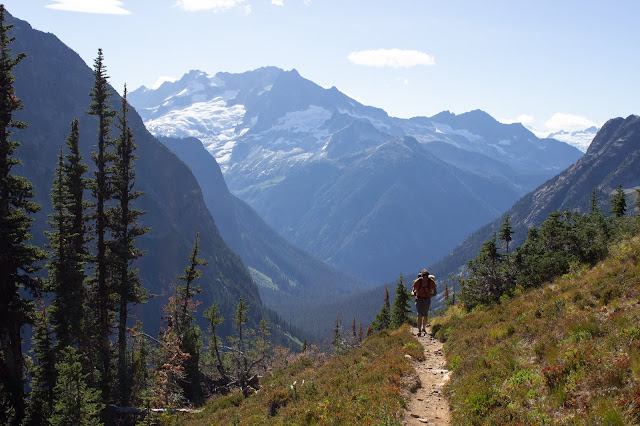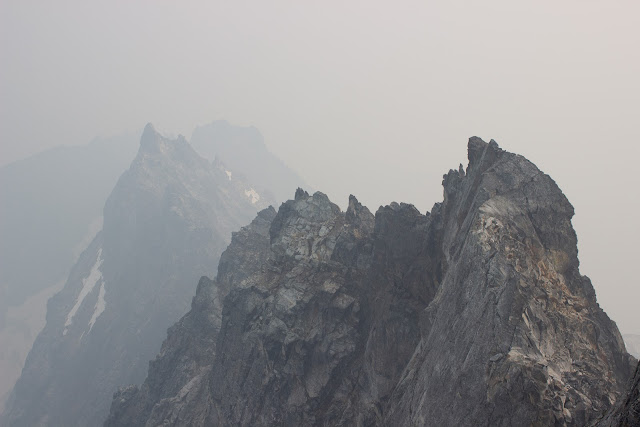Goode is one of the hidden giants of the Cascades, rising over a mile from the valley floor but not visible from any road. Its summit is guarded by steep walls of loose rock that repelled many attempts during the early 1930s. It was eventually climbed by Wolf Bauer, Joe Halwax, Jack Hossack, George MacGowan, and my great-grandfather Phil Dickert in July 1936. They approached from Stehekin and then climbed the south side of the mountain to the base of the fortified summit pyramid. They followed the most obvious weakness, climbing the Southwest Couloir until its walls funneled them into a steep chimney that had stymied previous parties. Wolf Bauer led the chimney, placing the first piton in the North Cascades. Fred Beckey offers a more complete description of the route in the Cascade Alpine Guide, but warns that it is "only of historical interest."
I do hope to repeat the route of the first ascent when I have time for the boat to Stehekin. For this trip, Nate and I decided to climb the magnificent Northeast Buttress of Goode then tag Storm King and continue to Logan over three days.
 |
| Goode's north face with the Northeast Buttress at center |
Nate and I drove out to the Bridge Creek trailhead on Thursday night and stashed a bike at the Easy Pass trailhead along the way. We started hiking at 11pm and followed the PCT south for about 10 miles to the junction with the North Fork of Bridge Creek. We got a few hours of sleep before the sun woke us and we started hiking again.
 |
| Mama black bear. Her two cubs are nearby |
The North Fork of Bridge Creek was an easy ford this late in the season. We crossed directly below the Northeast Buttress and took a direct line up talus, granite slabs, and slide alder to the base of the Goode Glacier.
 |
| Thankful to find a path through the slide alder |
The base of the Goode Glacier is a jumbled mess of seracs; a depressing sign of retreat. We traversed to the right and found a way onto the glacier via a short step of near vertical ice. I used both of our ice axes to lead the step and then passed them back down to Nate. We hadn't brought pickets or ice screws so I was unable to offer Nate a belay. He had never climbed ice before, but still crushed it!
 |
| Traversing below the Goode Glacier |
 |
| Nate above the short steep step |
We weaved a line thorough the broken glacier and eventually made it to the left side of the NE Buttress. A gaping moat separated us from the rock, bridged by a sliver of snow. The bridge will not be there for long, and without it gaining the NE Buttress will require an overhanging rappel into the moat. I wouldn't recommend it at this point in the season.
 |
Next step: Cowboy Arête on the Cassin Ridge
Photo: Nate Redon |
 |
| Looking back at the snowbridge that we used to gain the NE Buttress |
We traversed to the ridge crest on a ledge system of fairly loose rock. Once on the ridge the rock quality improved significantly and we enjoyed carefree scrambling up heathered ledges. Eventually the ridge steepened and we found ourselves too far left. We regained the ridge and climbed along the crest, simuling and occasionally belaying. Our rack of 8 nuts wasn't of much use in the generally parallel cracks, but the climbing was secure. We eventually made it to the bivy ledge and took a short break.
 |
| Logan and the source of the North Fork of Bridge Creek |
 |
| Goode Glacier with Black Peak on the left |
 |
| Taking a break at the bivy ledge |
We climbed the ridge to the right of the bivy and found the rock solid and the climbing fun. We made it to the summit with a couple hours of daylight left. It looked like a spectacular place to spend the night, but we still wanted to climb Storm King and Logan so we used the last of the light to start the descent.
 |
| A glory from the summit of Goode |
 |
| Buckner shrouded in clouds |
 |
| Fernow and Bonanza |
We made three rappels to Black Tooth notch, getting the rope stuck on the second one. Not wanting to climb back up, we built a 3-1 pulley with two microtraxions and pulled it free. We downclimbed past the first rappel station in the Southwest Couloir then made two rappels straight down. The first rappel we made was a full 30 meters and pulling the rope brought a lot of small rocks down.
 |
| Descending into the shadows |
 |
Rappelling into the Southwest Couloir
Photo: Nate Redon |
We scrambled down the couloir and exited skier's left to avoid a cliff band at its base. It was getting dark, so we slid down some scree and found a nice bivy site next to a small stream at 7,700'.
 |
| Booker and Buckner at dusk |
The night didn't feel much like summer. When the sun rose our bags were coated in frost and our water bottles frozen. I was glad that Nate had not wanted to sleep on the summit.
 |
| The morning after a cold night |
We eventually emerged from our sleeping bags and started traversing talus towards Storm King. We emptied most of the gear from our packs and left our sleeping bags out to dry in the sun.
We worked our way up steep scree on Storm King's south face, followed an exposed ledge system around the north side of the mountain, and scrambled to the summit.
 |
| Scrambling across an exposed ledge on the NE side of Storm King |
 |
| Goode from Storm King with the north face on the left |
We scrambled back to the south side of the mountain and skied surprisingly enjoyable scree back to our gear.
 |
| Taking a break after descending Storm King |
 |
| Agnes, Gunsight, Sinister, Glacier, and Dome |
We picked up a climber's trail and followed it down a ridge southwest of Goode's summit. The trail is easy to follow until it enters the burn zone of the 2015 Goode fire. Here, we traversed skier's left to the edge of a large washout and eventually picked up a trail to the valley floor. A bit of bushwhacking brought us to the Park Creek Trail.
 |
| Fireweed dominates after the 2015 Goode fire |
 |
| Ant versus inchworm: who will win? |
We started up towards Park Creek Pass enjoying beautiful views and plentiful huckleberries along the way.
 |
| Feasting on huckleberries at Park Creek Pass. The resident marmot had obviously had his fill. |
There were only a couple hours of light left by the time we made it over the pass. We filled our water and discussed whether or not we should climb Logan. Our original plan was to ascend the Fremont Glacier and descend the Douglas or Banded Glacier then exit via Easy Pass. Steph Abegg reported a massive barely-bridged crevasse on the Banded Glacier on August 2nd (2012), and we were pretty sure that it would have melted out this late in the season. We were able to see a some of the Douglas Glacier from Goode and it looked quite difficult to cross. If neither option worked our shortest way out would be reversing the Fremont Glacier, hiking 18 miles to Diablo Lake, and hitching a ride 30 miles back to the car. We were pretty sure that heading up Logan would end in Nate missing his first shift at work on Monday, so we decided not to do it. Oh well, I'll be back with my skis.
We hiked down Thunder Creek until the sun set and made camp. In the morning, we continued down Thunder Creek and then up Fisher Creek to Easy Pass.
 |
| Remnants of an old mine on the Thunder Creek trail |
 |
| Hiking out Easy Pass with Logan and the Douglas Glacier in the background |
We made it back to the car a couple hours before sunset. Biking over Rainy Pass sounded thoroughly unappealing so I tried to hitch a ride. There weren't many people headed east on Sunday evening, but eventually a really nice couple picked me up and fed me homemade cookies. It was the perfect end to an excellent adventure.
Gear notes:
- Approach shoes, crampons, ice axes
- 8 small nuts and 5 slings for NEB
- 60m half rope, doubled for simuling
































































